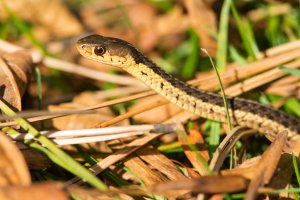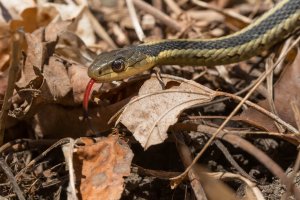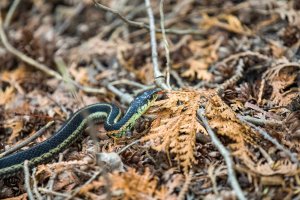Wild Wednesday: Eastern Garter Snakes
Slithering into fall with Eastern Garter Snakes
Erin Parker, Interpretive Services Supervisor, August 31, 2022
Garden snake, gardener snake, garter snake. All of these common names refer to the same creature, one of southeastern Michigan’s most common reptiles: the garter snake. While they may be found in and near gardens, their name likely comes from their yellow or cream stripes. These stripy snakes reminded people of the striped garters once used to hold up socks and stockings before the use of elastic!

Garter snakes are a large group of about 35 species and subspecies. Our most common garter snake is the eastern garter snake. They are typically dark brown or even black with three cream-colored or yellow-ish stripes running from head to tail, but colors vary widely! Some individuals appear nearly solid black and others have hints of copper, green, and even blue. They are slim snakes and their forked tongues are bright red. Two close relatives, Butler’s garter snake and Northern Ribbon snake, can also be found among Michigan’s 18 snake species.

One word that might describe garter snakes is adaptable. They can be found throughout Eastern North American in urban parks, rural backyards, and just about everywhere in between. They consume a diverse diet, as well. Eastern garter snakes regularly eat frogs, toads, small salamanders, slugs, grasshoppers, and even worms.
Eastern garter snakes give birth to live young in the spring, instead of laying eggs externally like many other reptiles. Garter snakes as all stages of their life make good food for birds, raccoons, snapping turtles, foxes, coyotes, and many others- but especially when they’re young. Like most other reptiles, garter snakes don’t provide any care to their young.
This time of year, garter snakes may be regularly seen basking in the sun on trails and sidewalks. Starting in October, they’ll search out cracks, crevices, and other small spaces in which to hibernate. In some places, huge numbers of garter snakes congregate- the emergence of 70,000+ garter snakes in Manitoba, Canada is an annual event each year during the first warm days of spring!
Like all of Michigan’s snakes, Eastern Garter Snakes are an important part of our landscapes, ecosystems, and food chains. They help keep populations of smaller prey in check, and provide food for a variety of predators.

Snakes are too often killed because we harbor misconceptions about the dangers they pose. While our initial response to a surprise snake along our path might be fear, snakes can encourage curiosity, too! When encountering a snake soaking up the warmth of late summer, can you take a moment to observe it? Even if you are startled, the best thing to do for snakes is to let them be. Toads and grasshoppers need to beware lest they become a tasty meal, but we can simply observe them without concern for our safety. As summer comes to a close, seek out snakes along the trail and enjoy a quiet observation before winter’s cold sends them into hibernation.
